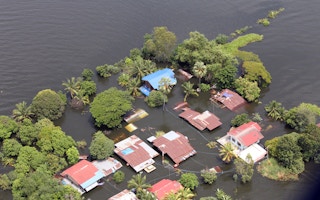Bitter cold in the United States might appear to contradict the notion of global warming, but with Britain’s wettest winter and Australia’s hottest summer, extreme weather events have pushed climate change back on the political agenda.
A spluttering world economy had sapped political interest in the billion-dollar shifts from fossil fuels that scientists say are needed to cut greenhouse gas emissions, but rhetoric is changing in 2014, one year before a deadline for a new UN climate deal.
US Secretary of State John Kerry went furthest, calling climate change “perhaps the most fearsome weapon of mass destruction” and ridiculing those who doubt that climate change is man-made.
Almost 200 governments have agreed to work out a deal at a summit in Paris in December 2015 to combat rising global temperatures which a UN panel of scientists has predicted will cause increasing extreme weather and rising seas.
“
Most nations have yet to say what curbs they will impose on carbon emissions in 2015, in a deal that could influence energy investments from coal to wind power
The deal would replace the 1997 Kyoto Protocol - the world’s first attempt to agree emissions reductions which was spurned by the United States and which did not impose limits on rapidly developing economies like India and China.
With wild weather hitting some of the most developed parts of the world, politicians in rich nations are once again under pressure to address the issue.
“Attention has been increasing … sadly because of the increase in the frequency and intensity of natural events and disasters,”, UN climate change chief Christiana Figueres told Reuters.
“The scale and speed of action needs to improve,” she said, adding that disasters in the past two or three years including 2013’s Typhoon Haiyan in the Philippines had also focused minds.
US President Barack Obama and French President Francois Hollande last week urged an “ambitious” climate deal in 2015, which would come into force from 2020.
Large parts of the United States and Canada suffered bone-numbing cold last month that some scientists say could be a paradoxical side-effect of disruptions to the jet stream linked to climate change. Britain has had the wettest December to January on record, with widespread floods.
Sleepwalking
British opposition leader Ed Miliband said at the weekend that Britain was “sleepwalking to a climate crisis”.
Last year was the warmest on record in Australia with heatwaves, droughts and wildfires. Prime Minister Tony Abbott is skeptical of a link to man-made global warming.
“If you look at the records of Australian agriculture going back 150 years, there have always been good times and bad,” he told reporters during a tour of drought-stricken farming regions this week. “This is not a new thing in Australia.”
Last year, the UN’s Intergovernmental Panel on Climate Change raised the probability that mankind was the main cause of global warming since the mid-20th century to at least 95 per cent from 90 per cent assessed in 2007.
Most nations have yet to say what curbs they will impose on carbon emissions in 2015, in a deal that could influence energy investments from coal to wind power.
“It’s very good that international leaders are increasingly recognising the threat of climate change,” Connie Hedegaard, the European Union’s climate commissioner, told Reuters.
“But leaders must walk the talk with concrete and forward-looking actions and pledges.”
The European Commission has proposed a 40 per cent cut in the bloc’s emissions by 2030 from 1990 levels, after a 20 per cent cut by 2020.
China, the top greenhouse gas emitter, ahead of the United States, has an added incentive to cut emissions - disastrous levels of air pollution caused by its rising use of coal.
“There will be more to see on China’s (climate) plans around June 2015,” Jiang Kejun at state-run think-tank Energy Research Institute told Reuters. He said China aimed to set a cap on energy consumption and carbon emissions in its next five-year plan, from 2016.
Most experts say that any 2015 deal is likely to be well short of deep cuts in emissions that scientists say are needed to limit global warming to a UN goal of no more than 2 degrees Celsius (3.6 Fahrenheit) above pre-industrial times.
But those pushing for action are encouraged by the change in rhetoric. “The pace is starting to pick up,” said Alden Meyer, of the Union of Concerned Scientists.










